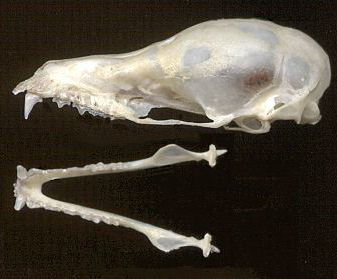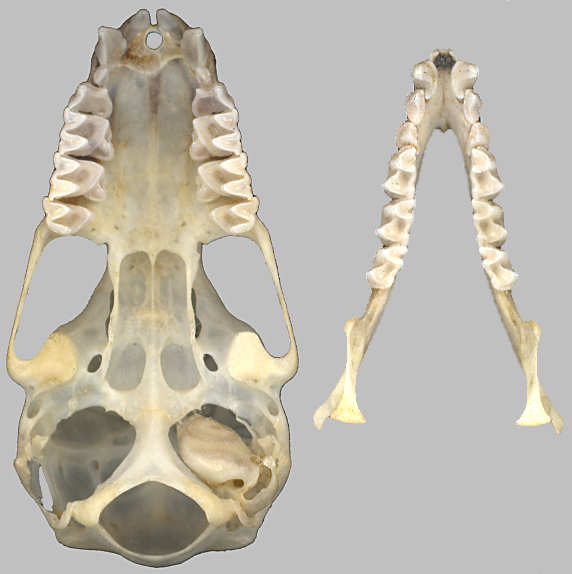Family Mormoopidae—Ghost-faced Bats. Mormoops megalophylla (Peter's Ghost-faced Bat) occurs in the southernmost counties of the Big Bend. According to Schmidly (1977:32), "collecting localities closely follow areas having annual precipitation of ten to twelve inches and average annual temperature above 64° F."
 Family
Phyllostomidae—New World Leaf-nosed Bats. The phyllostomids are mostly tropical and
subtropical bats of the Americas, but several species overlap into the southern
portions of the U.S., retreating to the south in the cold seasons. Three of the species
in our region are nectivorous: Leptonycteris nivalis, L. yerbabuenae (also has
been known under the names of L. curasoae, L. sanborni,) and Choeronycteris
mexicana. The first of these enters Big Bend in the U.S., but has most of its
geographic range in Mexico, with its southernmost occurrences in Guatemala.
Choeronycteris mexicana occurs from the vicinity of San Diego in California east
to the bootheel of New Mexico and south to Honduras; an anomalous record is from El
Paso in December. The California Leaf-nosed Bat (Macrotus californicus closely
approached New Mexico in southeastern Arizona.
Family
Phyllostomidae—New World Leaf-nosed Bats. The phyllostomids are mostly tropical and
subtropical bats of the Americas, but several species overlap into the southern
portions of the U.S., retreating to the south in the cold seasons. Three of the species
in our region are nectivorous: Leptonycteris nivalis, L. yerbabuenae (also has
been known under the names of L. curasoae, L. sanborni,) and Choeronycteris
mexicana. The first of these enters Big Bend in the U.S., but has most of its
geographic range in Mexico, with its southernmost occurrences in Guatemala.
Choeronycteris mexicana occurs from the vicinity of San Diego in California east
to the bootheel of New Mexico and south to Honduras; an anomalous record is from El
Paso in December. The California Leaf-nosed Bat (Macrotus californicus closely
approached New Mexico in southeastern Arizona.
Fig. 1. Lateral view of skull and dorsal view of mandible of Leptonycteris yerbabuenae.
These species appear to be heavily reliant on agave nectar and pollen during the time they are as far north as the U.S., although other flowers (including the giant cacti) also are utilized. These species move into Mexico during the non-flowering portions of the year. Some species of plants probably depend primarily on nectivorous bats for pollination (in the Old World, megachiropterans appear to be important in the distribution of seeds of many tropical plants; frugivorous microchiropterans in the tropics may play a similar role).
 Family Molossidae—Free-tailed Bats. The common name for this family is
based on the ability of the members to retract the uropatagium toward the body, leaving
an appreciable amount of tail extending beyond the end of the membrane (it may be
extended toward the tip of the tail at will, however, as during flight). As a family,
these are fast-flying animals that also are able to move rapidly on the ground in a
quadrupedal manner. The adaptation for rapid flight includes a long, narrow wing (high
aspect ratio wing); many species are unable to take off from the ground, but instead
have to climb high enough for a drop to attain flying speed; under normal
circumstances, such species roost high enough so that they can free-fall to obtain
flying speed.
Family Molossidae—Free-tailed Bats. The common name for this family is
based on the ability of the members to retract the uropatagium toward the body, leaving
an appreciable amount of tail extending beyond the end of the membrane (it may be
extended toward the tip of the tail at will, however, as during flight). As a family,
these are fast-flying animals that also are able to move rapidly on the ground in a
quadrupedal manner. The adaptation for rapid flight includes a long, narrow wing (high
aspect ratio wing); many species are unable to take off from the ground, but instead
have to climb high enough for a drop to attain flying speed; under normal
circumstances, such species roost high enough so that they can free-fall to obtain
flying speed.
Unlike the Phyllostomidae, which is strictly New World, the molossids are widespread in the warmer climates of both Old and New worlds. In the U.S. free-tails occur mostly in the southern portion of the country, though there are occurrences farther north.
Fig. 2. Big Free-tailed Bat (Nyctinomops macrotis) skull and mandible. The inner ear capsule on the left side is missing in this specimen.
The best known of the U.S. molossids is Tadarida brasiliensis, the Brazilian Free-tailed Bat (in the older literature, T. mexicana). This is the species that forms the huge maternity roosts in such places as Carlsbad Caverns and Bracken Cave (also the famous Austin bridge bats)—roosts that at times have contained more than 10 million bats in a single roost. The U.S. populations migrate into Mexico during the colder weather, when insect population sizes are reduced or absent. Many of the bat reports from El Paso reflect the spring and fall migrations, when migrating lost or sick bats show up in greater numbers (as an aside, although bats may carry rabies, the danger of humans contracting rabies from bats is low; skunks, raccoons, and domestic animals are a much greater danger. Nevertheless, bats in unusual places should be treated with caution, since these are the ones likely to be sick—keep children and pets away from them, cover with a container such as a jar if they're on the ground, and call Animal Control). These migrants spend the colder months in Mexico and then move north again in spring to form maternity roosts; males for the most part roost and hunt in different habitats. The superb flying ability of these animals allows them to cover a lot of territory (over 50 miles during a night for many) and remain aloft for hours.
The other species within our region are less common. Nyctinomops femorosaccus (Pocketed Free-tailed Bat) has been taken at Carlsbad Cavern and in Big Bend in the eastern part of the area, but most U.S. records are from southern California and southern Arizona (with an occurrence in the bootheel of New Mexico); distribution in Mexico is primarily northwestern to as far south as Michoacán. Nyctinomops macrotis (Big Free-tailed Bat) gets as far north as central Utah and Colorado and from there south well into Mexico, but appears relatively uncommon. There are records from El Paso. Both of these species formerly were placed in the genus Tadarida.
Eumops perotis, the Western Mastiff Bat, is the largest of the U.S. bats (forearm more than 65 mm in length). Its range is from northern California southeast to Langtry, Texas, and south into Mexico, but it appears absent from our region except for occurrence in the bootheel of New Mexico.
Last Update: 23 Jan 2008
Centennial Museum and Department of Biological Sciences, The University of Texas at El Paso